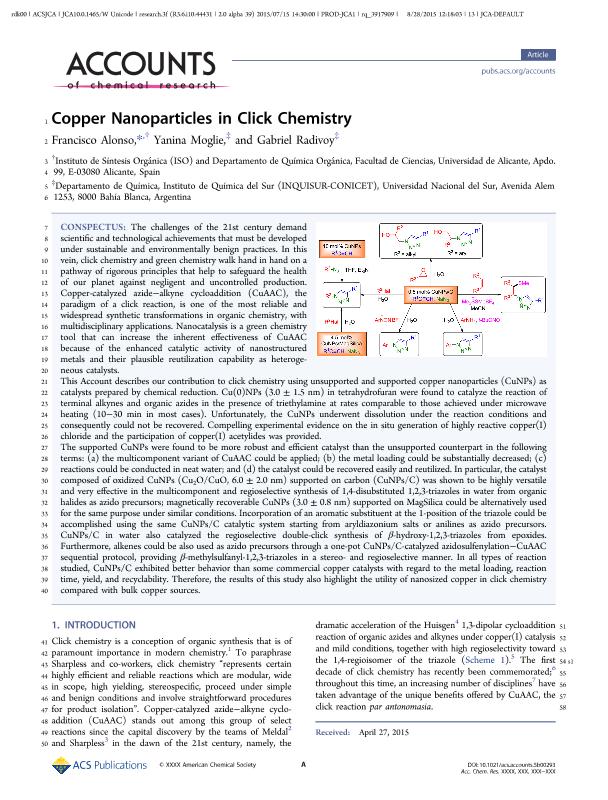Artículo
Copper Nanoparticles in Click Chemistry
Fecha de publicación:
09/2015
Editorial:
American Chemical Society
Revista:
Accounts of Chemical Research
ISSN:
0001-4842
Idioma:
Inglés
Tipo de recurso:
Artículo publicado
Clasificación temática:
Resumen
The challenges of the 21st century demand scientific and technological achievements that must be developed under sustainable and environmentally benign practices. In this vein, click chemistry and green chemistry walk hand in hand on a pathway of rigorous principles that help to safeguard the health of our planet against negligent and uncontrolled production.Copper-catalyzed azide−alkyne cycloaddition (CuAAC), the paradigm of a click reaction, is one of the most reliable and widespread synthetic transformations in organic chemistry, with multidisciplinary applications. Nanocatalysis is a green chemistry tool that can increase the inherent effectiveness of CuAAC because of the enhanced catalytic activity of nanostructured metals and their plausible reutilization capability as heterogeneous catalysts.This Account describes our contribution to click chemistry using unsupported and supported copper nanoparticles (CuNPs) as catalysts prepared by chemical reduction. Cu(0)NPs (3.0 ± 1.5 nm) in tetrahydrofuran were found to catalyze the reaction of terminal alkynes and organic azides in the presence of triethylamine at rates comparable to those achieved under microwave heating (10−30 min in most cases). Unfortunately, the CuNPs underwent dissolution under the reaction conditions and consequently could not be recovered. Compelling experimental evidence on the in situ generation of highly reactive copper(I) chloride and the participation of copper(I) acetylides was provided.The supported CuNPs were found to be more robust and efficient catalyst than the unsupported counterpart in the following terms: (a) the multicomponent variant of CuAAC could be applied; (b) the metal loading could be substantially decreased; (c) reactions could be conducted in neat water; and (d) the catalyst could be recovered easily and reutilized. In particular, the catalyst composed of oxidized CuNPs (Cu2O/CuO, 6.0 ± 2.0 nm) supported on carbon (CuNPs/C) was shown to be highly versatile and very effective in the multicomponent and regioselective synthesis of 1,4-disubstituted 1,2,3-triazoles in water from organic halides as azido precursors; magnetically recoverable CuNPs (3.0 ± 0.8 nm) supported on MagSilica could be alternatively used for the same purpose under similar conditions. Incorporation of an aromatic substituent at the position of the triazole could be accomplished using the same CuNPs/C catalytic system starting from aryldiazonium salts or anilines as azido precursors. CuNPs/C in water also catalyzed the regioselective double-click synthesis of β hydroxy-1,2,3-triazoles from epoxides.Furthermore, alkenes could be also used as azido precursors through a one-pot CuNPs/C-catalyzed azidosulfenylation−CuAAC sequential protocol, providing β-methylsulfanyl-1,2,3-triazoles in a stereo- and regioselective manner. In all types of reaction studied, CuNPs/C exhibited better behavior than some commercial copper catalysts with regard to the metal loading, reaction time, yield, and recyclability. Therefore, the results of this study also highlight the utility of nanosized copper in click chemistrycompared with bulk copper sources.
Palabras clave:
Click Chemistry
,
Copper Nanoparticles
,
Triazoles
Archivos asociados
Licencia
Identificadores
Colecciones
Articulos(INQUISUR)
Articulos de INST.DE QUIMICA DEL SUR
Articulos de INST.DE QUIMICA DEL SUR
Citación
Alonso, Francisco; Moglie, Yanina Fernanda; Radivoy, Gabriel Eduardo; Copper Nanoparticles in Click Chemistry; American Chemical Society; Accounts of Chemical Research; 48; 9-2015; 2516-2528
Compartir
Altmétricas




